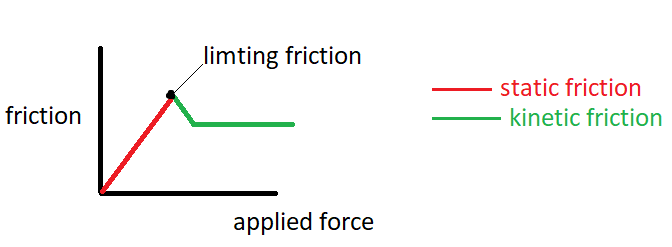
Mark the correct statements about the friction between two bodies.
(A) Static friction is always greater than the kinetic friction.
(B) coefficient of static friction is always greater than the coefficient of kinetic friction
(C) Limiting friction is always greater than the kinetic friction
(D) Limiting friction never less than static friction
Answer
216k+ views
Hint Assume that you’re placing a block on a surface that isn’t said to be smooth. Friction is the opposing force by the surface on the body, when the body is pushed or pulled. Apply this concept and select the correct options.
Complete Step By Step Solution
When a pull of push force is applied on the block on a surface, it experiences a constant static friction. As and when it is in contact with the surface, the surface opposes the block’s motion over a certain period of time. As and when we start to apply greater force on the body, the body will begin to accelerate with a kinetic friction. Now the friction value decreases, since the body is moving . When the body is said to be static, the amount of friction exerted by the surface on the body will be greater , until the force applied on the body exceeds the holding friction value. Hence static friction is greater than kinetic friction since there are more forces that apply on the body to keep it stationary than the kinetic forces that make it accelerate.
The maximum static friction is called the limiting friction. Limiting friction certainly has a greater value than that of kinetic friction but never lesser than static friction since it is the maxima point of static friction.
The graph of the same is given below

Thus, Options (b) (c) (d) are the right answers for the given question.
Note It is not always essential that static friction should always be greater than that of kinetic friction. This is because static friction is not constant and depends upon the force applied on the body to move it which is a bit less than limiting friction. Hence we can’t conclude that static friction will always be greater than kinetic.
Complete Step By Step Solution
When a pull of push force is applied on the block on a surface, it experiences a constant static friction. As and when it is in contact with the surface, the surface opposes the block’s motion over a certain period of time. As and when we start to apply greater force on the body, the body will begin to accelerate with a kinetic friction. Now the friction value decreases, since the body is moving . When the body is said to be static, the amount of friction exerted by the surface on the body will be greater , until the force applied on the body exceeds the holding friction value. Hence static friction is greater than kinetic friction since there are more forces that apply on the body to keep it stationary than the kinetic forces that make it accelerate.
The maximum static friction is called the limiting friction. Limiting friction certainly has a greater value than that of kinetic friction but never lesser than static friction since it is the maxima point of static friction.
The graph of the same is given below

Thus, Options (b) (c) (d) are the right answers for the given question.
Note It is not always essential that static friction should always be greater than that of kinetic friction. This is because static friction is not constant and depends upon the force applied on the body to move it which is a bit less than limiting friction. Hence we can’t conclude that static friction will always be greater than kinetic.
Recently Updated Pages
JEE Atomic Structure and Chemical Bonding important Concepts and Tips

JEE Amino Acids and Peptides Important Concepts and Tips for Exam Preparation

Electricity and Magnetism Explained: Key Concepts & Applications

Chemical Properties of Hydrogen - Important Concepts for JEE Exam Preparation

JEE Energetics Important Concepts and Tips for Exam Preparation

JEE Isolation, Preparation and Properties of Non-metals Important Concepts and Tips for Exam Preparation

Trending doubts
JEE Main 2026: Application Form Open, Exam Dates, Syllabus, Eligibility & Question Papers

Derivation of Equation of Trajectory Explained for Students

Hybridisation in Chemistry – Concept, Types & Applications

Understanding the Angle of Deviation in a Prism

Understanding Collisions: Types and Examples for Students

How to Convert a Galvanometer into an Ammeter or Voltmeter

Other Pages
JEE Advanced Marks vs Ranks 2025: Understanding Category-wise Qualifying Marks and Previous Year Cut-offs

Units And Measurements Class 11 Physics Chapter 1 CBSE Notes - 2025-26

NCERT Solutions For Class 11 Physics Chapter 8 Mechanical Properties Of Solids

Motion in a Straight Line Class 11 Physics Chapter 2 CBSE Notes - 2025-26

NCERT Solutions for Class 11 Physics Chapter 7 Gravitation 2025-26

Ideal and Non-Ideal Solutions Explained for Class 12 Chemistry




